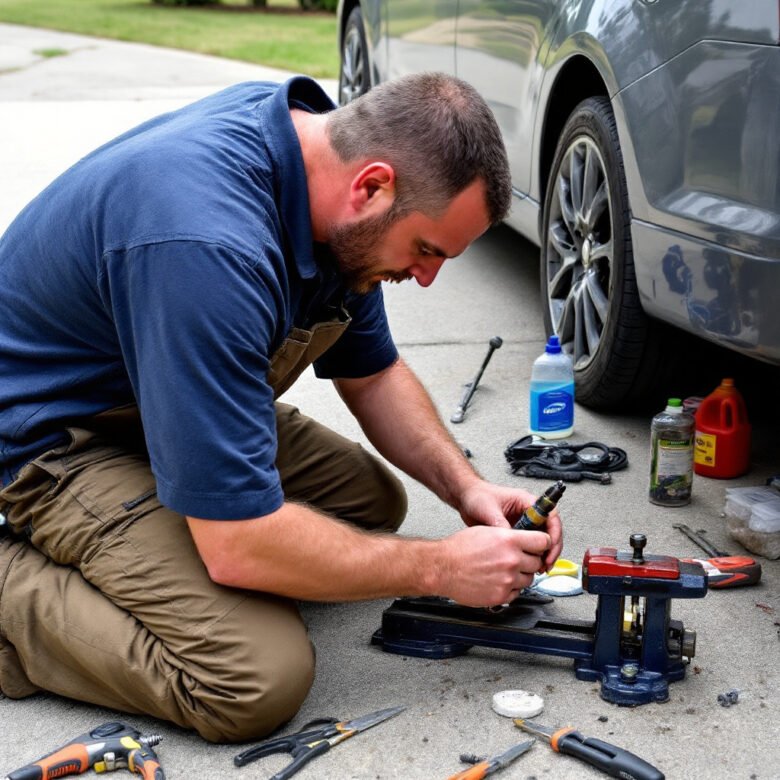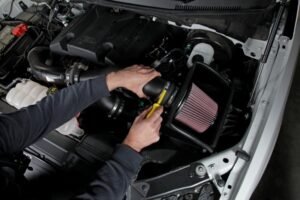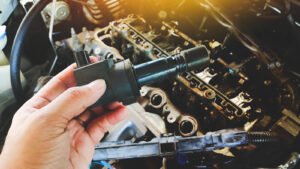Your car’s fuel injectors are tiny precision tools that spray fuel into the engine, ensuring it runs smoothly and efficiently. Over time, they can clog with carbon deposits, dirt, and gunk from low-quality gas, leading to rough idling, sluggish acceleration, or even misfires. Cleaning them yourself is a straightforward DIY fix that can restore pep to your ride, boost fuel economy, and save you from pricey shop bills (which can hit $100-$300). Plus, there’s nothing like the satisfaction of hearing your engine purr after a job well done!
In this guide, we’ll walk you through how to clean your fuel injectors using two popular DIY methods: a fuel injector cleaner additive (easiest) and a manual cleaning process (more hands-on). We’ll explain why it matters, what to watch for, and every step in detail so you can tackle it with confidence. Grab your tools, and let’s get your engine running like new!
Why Fuel Injectors Matter
Fuel injectors are like the chefs of your engine—they deliver the perfect mix of fuel and air for combustion. Each injector is a small nozzle that sprays a fine mist of gasoline (or diesel) into the engine’s cylinders at just the right moment. When they’re clean, your car runs smoothly, accelerates crisply, and sips fuel efficiently. But when they clog:
-
- Fuel spray gets uneven, starving the engine or flooding it.
-
- Performance drops—think hesitation, stuttering, or weak power.
-
- Emissions rise, and gas mileage tanks.
Cleaning them clears out the junk, restoring that factory-fresh feel. It’s a maintenance task that pays off in drivability and savings.
How Often Should You Clean Your Fuel Injectors?
-
- General Rule: Every 30,000-50,000 miles, or once a year, keeps them in good shape. Check your owner’s manual—some cars suggest intervals.
-
- Signs It’s Time: Rough idle (shaking at stops), slow acceleration, engine misfires (feels like a hiccup), or a check engine light (codes like P0300 often point to injectors).
-
- Fuel Quality: Cheap gas or short trips speed up clogging—clean more often if that’s your routine.
The additive method is quick for mild buildup; manual cleaning digs deeper for stubborn gunk. We’ll cover both so you can choose.
Tools and Materials You’ll Need
Here’s what you’ll need, split by method. Having it all ready keeps the job smooth.
For Method 1: Fuel Injector Cleaner Additive (Easiest)
-
- Fuel Injector Cleaner: A bottle of quality cleaner (e.g., Sea Foam, Chevron Techron—8-16 oz, depending on tank size).
-
- Full Tank of Gas: To dilute and run the cleaner through.
-
- Owner’s Manual: Confirms tank size and fuel type.
For Method 2: Manual Cleaning (Hands-On)
-
- Fuel Injector Cleaning Kit: Includes a pressurized canister and adapter (about $30-$50 at auto stores).
-
- Replacement O-Rings: For injectors (cheap insurance—get a set for your car).
-
- Wrench Set: To disconnect fuel lines (often 10mm-17mm).
-
- Socket Set with Ratchet: For bolts or brackets.
-
- Screwdriver: Flathead or Phillips, for clamps or covers.
-
- Fuel Line Disconnect Tool: Car-specific (cheap at parts stores—check your model).
-
- Gloves: Protects from gas and cleaner—fuel’s nasty on skin.
-
- Safety Glasses: Shields eyes from sprays or spills.
-
- Rags: For spills and cleanup—gasoline’s messy.
-
- Bucket or Pan: To catch drips.
-
- Shop Towels: Absorbent for bigger messes.
-
- Owner’s Manual: Guides you to the fuel rail and specs.
Optional:
-
- Compressed air (blows out debris).
-
- Battery charger (if the process drains power).
DIY Steps to Clean Your Fuel Injectors
We’ll cover two methods—pick based on your comfort level and how dirty your injectors are. Each step is explained fully so you know why and how.
Method 1: Using a Fuel Injector Cleaner Additive
This is the simplest way—pour it in, drive, and let chemistry do the work. Great for routine maintenance or mild issues.
Step 1: Pick the Right Cleaner
-
- Why: Not all cleaners are equal—some are weak or harsh on parts.
-
- How: Grab a reputable brand (Sea Foam, Lucas, Techron) from an auto store. Check the bottle—matches your fuel type (gasoline or diesel) and tank size (e.g., 12-20 gallons). Your manual lists your tank capacity—don’t guess.
Step 2: Time It Right
-
- Why: Cleaner works best diluted in a full tank and run through the system.
-
- How: Wait till your tank’s nearly empty (low fuel light on is perfect). Head to the gas station with your cleaner bottle. Park away from pumps—safety first.
Step 3: Add the Cleaner
-
- Why: Gets it into the fuel system to dissolve gunk as you drive.
-
- How: Pop the fuel cap. Pour the whole bottle into the tank—use a funnel if you’re clumsy (spills waste it). Read the label—some say 1 oz per gallon; adjust if your tank’s small. Recap tight.
Step 4: Fill Up and Drive
-
- Why: A full tank spreads the cleaner evenly, and driving pushes it through the injectors.
-
- How: Fill the tank with fresh, high-quality gas (premium if your car likes it—manual says). Drive normally—highway’s best, 20-30 miles—to circulate it. The cleaner breaks down deposits, flushing them out via exhaust.
Step 5: Check Results
-
- Why: Confirms it worked—no point repeating a dud fix.
-
- How: Listen after driving—smoother idle? Better throttle response? If not, repeat once more or try Method 2. For big clogs, this might not cut it.
Method 2: Manual Cleaning with a Cleaning Kit
This is hands-on—disabling the fuel pump, hooking up a kit, and running cleaner directly through the injectors. Ideal for serious buildup.
Step 1: Prep Your Car Safely
-
- Why: Gasoline’s flammable, and pressure’s dangerous—safety’s key.
-
- How: Park on flat ground, engine off, in a well-ventilated spot (garage with doors open, or outside). Set the parking brake. Pop the hood, wear gloves and glasses—fuel sprays hurt. Let the engine cool if it’s been running—hot parts burn.
Step 2: Locate the Fuel Rail and Injectors
-
- Why: The fuel rail feeds the injectors—you’ll tap into it here.
-
- How: Open your manual—it shows the fuel rail (a metal or plastic pipe along the engine, with injectors poking out). Usually near the top, connected to a fuel line from the tank. Look for small nozzles (injectors) plugged into the engine—4, 6, or 8, depending on cylinders.
Step 3: Disable the Fuel Pump
-
- Why: Stops gas from flowing while you work—keeps pressure off.
-
- How: Find the fuel pump fuse or relay (manual or fuse box cover lists it—often under the hood or dash). Pull the fuse with your fingers or a puller, or unplug the relay. Start the car—it’ll stall in seconds as pressure drops. Turn it off, key out. No fuel flow now—safe to proceed.
Step 4: Disconnect the Fuel Line
-
- Why: Lets you bypass the tank and hook up the cleaning kit.
-
- How: Trace the fuel line from the rail to where it connects (often a quick-release fitting). Use a fuel line disconnect tool (slides in, pops it loose—size matches your car). Have a rag and bucket ready—some gas will drip. Cap the loose tank line with a rag or plug to stop leaks.
Step 5: Hook Up the Cleaning Kit
-
- Why: Runs cleaner straight through the injectors, blasting clogs.
-
- How: Grab your kit (a canister with a hose and nozzle). Pour in the cleaner fluid (kit includes it or specifies—don’t use additive here). Connect the kit’s hose to the fuel rail where the line was—tighten clamps or fittings (wrench or screwdriver). Hang the canister securely (hood latch works)—it’s pressurized soon.
Step 6: Pressurize and Run the Cleaner
-
- Why: Forces cleaner through, mimicking fuel delivery to scrub injectors.
-
- How: Follow kit instructions—some use shop air (connect a compressor), others a hand pump. Build pressure (usually 40-60 psi—kit says). Start the engine—it’ll run on the cleaner, not gas. Let it idle 5-10 minutes till the canister’s empty or engine stalls. You might see exhaust smoke—normal, it’s burning off gunk.
Step 7: Reconnect Everything
-
- Why: Gets your fuel system back to normal operation.
-
- How: Turn off the engine. Disconnect the kit—catch drips with rags. Reattach the fuel line to the rail—push till it clicks or tighten if bolted. Replace the fuel pump fuse/relay. Check O-rings on the rail fitting—swap if cracked (lube new ones with a dab of cleaner). No leaks? Good.
Step 8: Test and Finish Up
-
- Why: Ensures the car runs right and no mess is left.
-
- How: Start the engine—might crank a bit as fuel refills. Listen—smooth now? Drive a few miles—feel the power? Wipe spills (gasoline’s a fire risk), store tools, dispose of cleaner cans per local rules (recycle if possible).
Final Steps for Both Methods
Step 9: Monitor Performance
-
- Why: Confirms the fix worked—don’t assume.
-
- How: Drive a day or two—idle steady? Acceleration crisp? If not, repeat (Method 1) or escalate (Method 2 to a pro if stubborn).
Step 10: Clean Up Safely
-
- Why: Fuel and cleaner are hazards—tidy up right.
-
- How: Wipe tools, rags, and spills—gas-soaked stuff goes in a sealed bag, not trash (fire risk). Store fluids away from heat, kids, pets.
DIY Tips for Success
-
- Quality Fuel: Post-clean, use top-tier gas (Shell, Exxon)—less junk to clog again.
-
- Warm Engine: For Method 2, warm (not hot) engines loosen deposits—run 5 minutes first.
-
- Small Batches: Method 1—don’t overdo cleaner; one bottle per tank max.
-
- Check Filters: Dirty fuel filters mimic injector issues—swap if old.
-
- Log It: Note mileage and date—track when to clean next.
DIY Mistakes to Avoid
-
- Hot Work: Method 2 on a hot engine risks burns or fires—cool it down.
-
- Wrong Cleaner: Mismatched fluid (e.g., diesel in gas) gums things up—read labels.
-
- Fuel Leaks: Loose lines spark danger—double-check connections.
-
- Skipping Fuses: Pump running during Method 2 floods it—disable it.
-
- Overpressure: Too much psi in the kit damages injectors—follow specs.
DIY Troubleshooting
-
- Still Rough: Cleaner didn’t cut it? Injectors might be shot—test with a pro tool.
-
- Fuel Smell: Leak after Method 2—recheck fittings, tighten or replace seals.
-
- No Start: Pump fuse/relay not back? Battery dead from cranking? Fix those.
Wrap-Up: Rev Up Your Ride!
Cleaning your fuel injectors is a DIY power move that wakes up your engine and stretches your gas dollar. Method 1’s a breeze for upkeep—pour and go. Method 2 digs deep for the tough stuff—hands-on and rewarding. Pick your path, follow these steps, and enjoy the smoother, stronger drive. You’ve got this—hit the road with pride!




